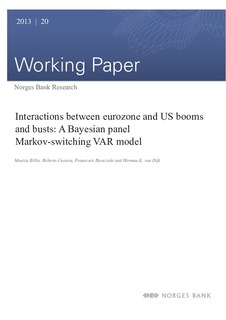| dc.contributor.author | Billio, Monica | |
| dc.contributor.author | Casarin, Roberto | |
| dc.contributor.author | Ravazzolo, Francesco | |
| dc.contributor.author | van Dijk, Herman K. | |
| dc.date.accessioned | 2018-05-02T10:50:23Z | |
| dc.date.available | 2018-05-02T10:50:23Z | |
| dc.date.issued | 2013 | |
| dc.identifier.isbn | 978-82-7553-773-5 | |
| dc.identifier.issn | 1502-8143 | |
| dc.identifier.uri | http://hdl.handle.net/11250/2496686 | |
| dc.description.abstract | Interactions between the eurozone and US booms and busts and among major eurozone economies are analyzed by introducing a panel Markov-switching VAR model well suitable for a multi-country cyclical analysis. The model accommodates changes in low and high data frequencies and endogenous time-varying transition matrices of the country-specific Markov chains. The transition matrix of each Markov chain depends on its own past history and on the history of the other chains, thus allowing for modelling of the interactions between cycles. An endogenous common eurozone cycle is derived by aggregating country-specific cycles. The model is estimated using a simulation based Bayesian approach in which an efficient multi-move strategy algorithm is defined to draw common time-varying Markov-switching chains. Our results show that the US and eurozone cycles are not fully synchronized over the 1991-2013 sample period, with evidence of more recessions in the eurozone, in particular during the 90's when the monetary union was planned. Larger synchronization occurs at beginning of the Great Financial Crisis. Shocks affect the US 1-quarter in advance of the eurozone, but these spread very rapidly among economies. There exist reinforcement effects in the recession probabilities and in the probabilities of exiting recessions for both eurozone and US cycles, and substantial differences in the phase transitions within the eurozone. An increase in the number of eurozone countries in recession increases the probability of the US to stay within recession, while the US recession indicator has a negative impact on the probability to stay in recession for eurozone countries. Moreover, turning point analysis shows that the cycles of Germany, France and Italy are closer to the US cycle than other countries. Belgium, Spain, and Germany, provide more timely information on the aggregate recession than Netherlands and France. | nb_NO |
| dc.language.iso | eng | nb_NO |
| dc.publisher | Norges Bank | nb_NO |
| dc.relation.ispartofseries | Working Papers;20/2013 | |
| dc.rights | Attribution-NonCommercial-NoDerivatives 4.0 Internasjonal | * |
| dc.rights.uri | http://creativecommons.org/licenses/by-nc-nd/4.0/deed.no | * |
| dc.subject | JEL: C11 | nb_NO |
| dc.subject | JEL: C15 | nb_NO |
| dc.subject | JEL: C53 | nb_NO |
| dc.subject | JEL: E37 | nb_NO |
| dc.subject | Bayesian model | nb_NO |
| dc.subject | Markov switching | nb_NO |
| dc.subject | panel VAR | nb_NO |
| dc.subject | international business cycles | nb_NO |
| dc.subject | interaction mechanisms | nb_NO |
| dc.title | Interactions Between Eurozone and US Booms and Busts: A Bayesian Panel Markov-Switching VAR Model | nb_NO |
| dc.type | Working paper | nb_NO |
| dc.description.version | publishedVersion | nb_NO |
| dc.subject.nsi | VDP::Samfunnsvitenskap: 200::Økonomi: 210::Samfunnsøkonomi: 212 | nb_NO |
| dc.source.pagenumber | 47 | nb_NO |

